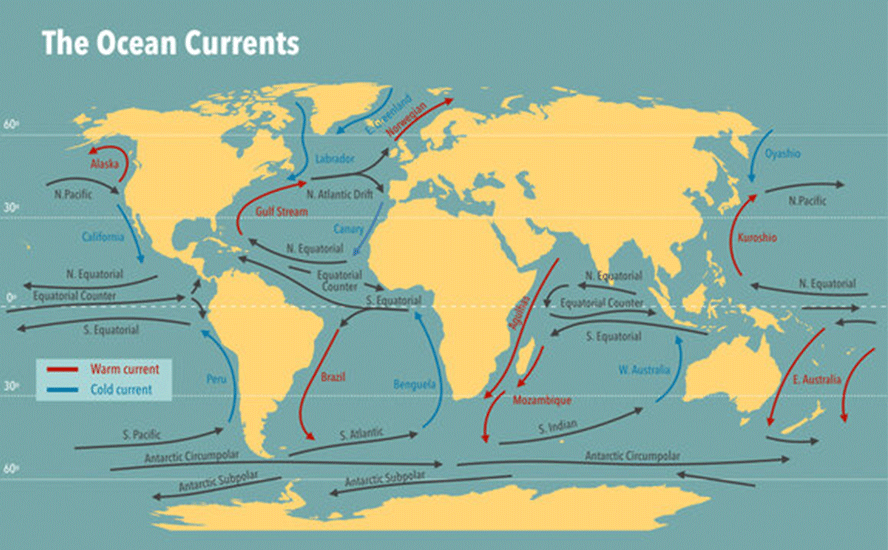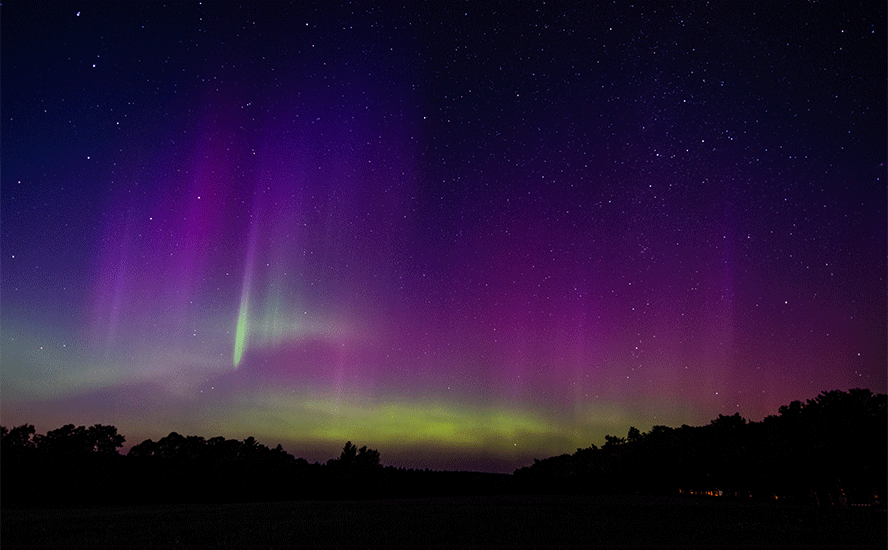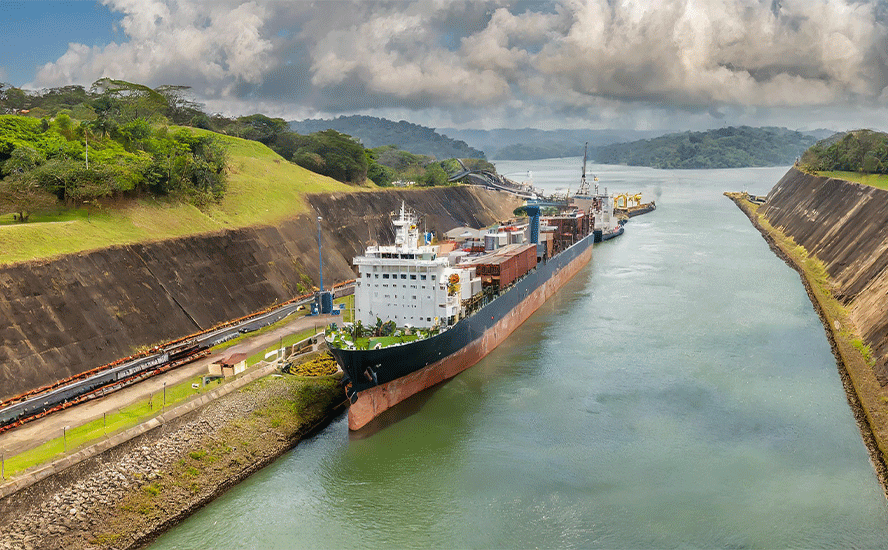Golden Triangles Red Line

2019.04.03
“Geologists are scrambling to understand what created the phenomenal concentrations of gold at the Valley of the Kings discovery of Pretium. Recent drill results include 0.5 meters that carried 41,582 grams per tonne gold (1.6 feet at 1,213 ounces per ton of gold). Another hole hit 2,393 g/t gold 1,605 g/t silver over 10.7 meters (70 ounces gold and 47 ounces of silver per ton over 35 feet). Numerous intersections have exceeded 1,000 g/t, grades rarely seen in gold deposits.
The broad picture, in simplest terms, is that most of British Columbia is made up of blocks of crustal material (terranes) that have been accreted to the coast over a period of hundreds of millions of years. Those terranes include a wide variety of rock types, including metal-rich material derived from the depths of the crust.
Most metal deposits are derived from hydrothermal systems. That is, superheated water, circulating kilometers deep in the crust, gathers metal atoms and then deposits them in particular zones, creating concentrations of metals. Typically, such a system would remain active for hundreds of thousands of years to as much as perhaps a couple of million years. For reasons not yet well understood, the hydrothermal processes in the Golden Triangle were active for much longer, in some areas for perhaps 10 million years. Few areas on the planet have seen such long-lived geological conditions.
That long period of stable mineralizing systems played an important role in creating the high concentrations of metals at Eskay Creek and Valley of the Kings. It is also the reason for the very large and well mineralized systems at Red Chris, KSM, Galore and other porphyry deposits in the region.”Kitco.com, British Columbia’s Golden Triangle
About 150 million years ago during the Jurassic geological period, an uplift of Jurassic and older rocks cut across central British Columbia and resulted in the separation of the Bowser and Nechako basins. Rocks exposed along the “Skeena Arch” represent a magmatic arc, where over a long period of time, magma rose up from deep in the earth to produce a wide range of mineral deposits including porphyries, precious metal veins, and coal. The Skeena Arch has some of the mostly richly endowed mineral terrain in BC and has been a destination for prospectors and mining companies for the past 125 years.
The map below shows the Golden Triangle where a lot of historical exploration and mining has taken place in the last century and a quarter, and where over the past couple of years juniors have rushed in to stake claims as mineral exploration conditions and the gold market have improved.

Note the three arches bounding the Golden Triangle in the second map: the Skeena Arch, Central Stikine and Stikine Arch. The Stikine Arch is one of four terranes – or distinct geological structures with different histories – along with Cache Creek, Yukon-Tanana and Cassiar, which form the bedrock of the Northern Cordilleran Volcanic Province, a wide belt of volcanoes that extends all the way from Stewart, BC in the south, through the Alaska Panhandle north to eastern Alaska. According to a presentation by Geoscience BC, “World class gold-rich deposits are associated with the Late Triassic, and Early Jurassic intrusive suites in NW Stikinia.” The non-profit research group also states that bulk tonnage copper/ gold/ silver porphyries (igneous rock consisting of large-grained crystals such as feldspar or quartz) in the Stikinia, and bonanza-grade gold and silver epithermal veins are associated with the early Jurassic period, such as the KSM (Seabridge), Snowfield and Brucejack (Pretium) deposits.
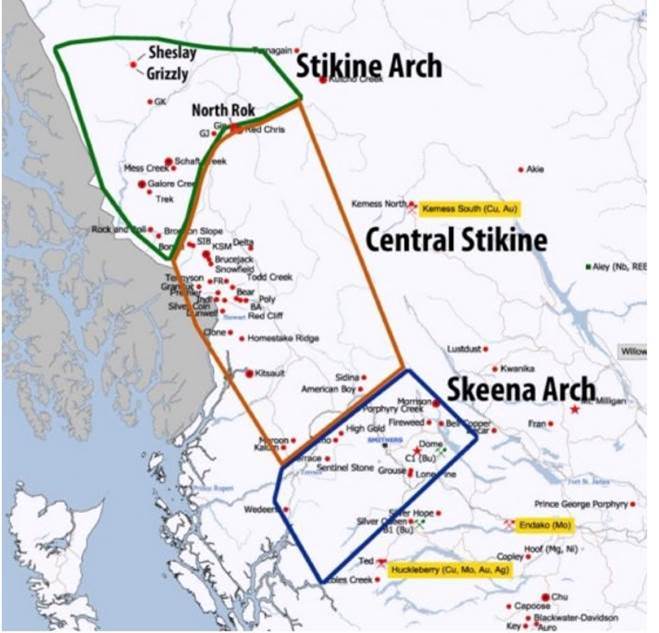
This article will trace the history of the Golden Triangle, explain why the area has become hot again after many years of neglect, and present a few junior resource company successes from the Triangle last year. Lastly, we’ll roll out a watchlist of juniors that are on our radar as potentially hitting the next big discovery hole.
A brief history
Just inland from the Alaska Panhandle, the Golden Triangle has been the site of three gold rushes and some of Canada’s greatest mines, including Premier, Snip and Eskay Creek. Other significant and well known deposits located within the Triangle include Brucejack, Galore Creek, Copper Canyon, Schaft Creek, KSM, Granduc, and Red Chris.
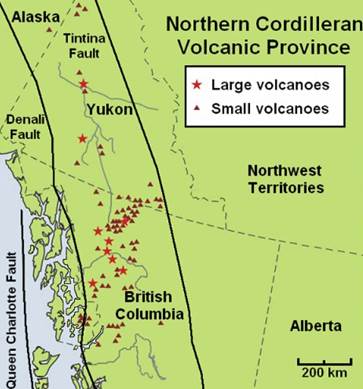
Alexander Choquette kicked off the Stikine Gold Rush in 1861 after finding gold at the confluence of the Stikine and Anuk Rivers.
Premier Gold Mine, which started operations at Premier in 1918, returned 200% on the stock market between 1921 and 1923. The Snip Gold Mine produced a million ounces in the 1990s at an eye-popping average grade of 27.5 grams per tonne (g/t), and Eskay Creek was Canada’s highest grade gold mine and the world’s fifth largest silver producer, with production well over 3 million ounces of gold and 160 million ounces of silver, before it closed in 2008.
Porphyry copper-gold deposit Galore Creek, now owned by Novagold and Teck Resources, has 9 billion pounds of copper, 8 million gold ounces and 136 million ounces of silver. Another porphyry, Shaft Creek, a JV between Copper Fox Metals and Teck, contains 5 billion pounds of copper, 5.8 million ounces of gold, 363.5 million pounds of molybdenum and 51.7 million ounces of silver. (2013 feasibility study)
But after decades of productive mining and some big discoveries, the Golden Triangle went dormant. Isolated from major infrastructure, the area was expensive to conduct sampling, surveys and drill programs, and due to its harsh winter climate, was only accessible for half a year. Not much news came out of the Golden Triangle during the 1990s and 2000s. When gold prices weakened, to about $400 an ounce, several mines shut down, unable to make a decent margin against fixed costs.
What changed?
Despite over 130 million ounces of gold, 800 million ounces of silver and 40 billion pounds of copper having been found in the area, the tip of the surface has only been scratched. The BC Geological Survey database has identified over 900 mineral occurrences, 67 of which have documented mineral resources.
Lately there has been a resurgence of interest in the Golden Triangle, with something of a staking rush going on there as juniors position themselves for the next discovery hole. So what changed? The excitement is being driven by five factors.
1. New deposits
In 2009 exploration drilling at the Valley of the Kings deposit – the site of a former gold mine – hit a bonanza hole of four mineralized gold bands, with the highest grading 16,949 grams per tonne, leading to a 33,000-meter drill program in 2010. New company Pretium, led by Bob Quartermain, former president of Silver Standard Resources, proceeded to develop the Brucejackproject, with a PEA completed the same year. More drilling and a 10,000-tonne bulk sample revealed that unlike porphyry-style deposits in the area, the Valley of the Kings contained high-grade stockwork-style (a complex system of veins) gold. At 8.1 million ounces graded 16.1 grams per tonne, Pretium had some of the richest ore in the world. After a feasibility study in 2013 and permits and financing in 2015, mine construction started in 2016, with the first gold pour last July.
Also critical to the revival of the Triangle was Seabridge’s KSM project. Considered the largest gold project in the world, with reserves of 38.8 million ounces of gold, 10.2 billion pounds of copper and 183 million ounces of silver, KSM was green-lighted by the Canadian federal government in 2014. The discovery of the Deep Kerr and Iron Cap Zones are expected to increase the resource estimate; mining would be done via the underground block cave method.
Then there’s Red Chris. Run by Imperial Metals, this $700 million gold and copper mine entered production in 2015. In 2017 Red Chris produced 74.6 million pounds of copper, 33,416 oz gold and 133,157 oz silver.
2. New infrastructure
New road and power infrastructure built by the BC government includes the paving of the Stewart-Cassiar Highway north from Smithers; port facilities for export of concentrate opened at the town of Stewart; and most importantly, a $700 million high voltage transmission line to bring power to mining properties previously unaccessible to the grid and reliant on diesel-powered portable generators.
3. Declining snow cover
The retreat of glaciers in the upper elevations of the Golden Triangle have revealed rocks never before seen – fuelling the curiosity of exploration geologists. In 2015 British Columbia experienced one of the most dramatic melts of glacial cover, with up to 10 centimeters of ice lost per day in summer that is not being replaced during the winter. Glacier researchers predict much of Western Canada’s 25,000 square kilometers of ice fields won’t last the century. The photo below compares the Bear Glacier northeast of Stewart in 1978 and 2013.

4. New geological theory
While the geology of the Golden Triangle has been well known for decades, it took a new twist to get geologists back into the field. Jeff Kyba, a former geo with the BC government, theorized that geologic contact between Triassic age Stuhini rocks and Jurassic age Hazelton rocks is the key marker for copper-gold mineralization. That means most of the Golden Triangle’s deposits are found within 2 kilometers of this contact zone, which Kyba and his team dubbed “The Red Line”. His theory, published in a BC government paper, was significant because it was the first time anyone had tied the area’s discoveries together with a structural explanation.
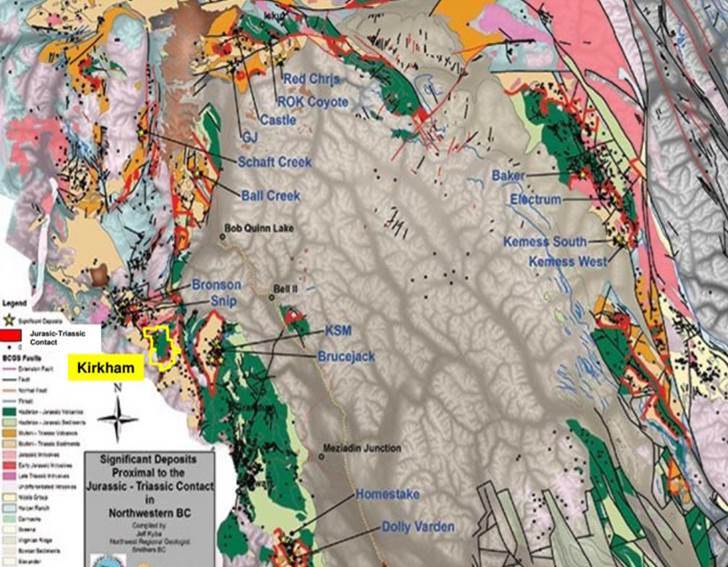
Red Line in above picture is the Stuhini-Hazelton group stratigraphic contact
By: Lesley Stokes May 6, 2015 Northern Miner – Volume 101 Number 13 May 11 – 17, 2015 VANCOUVER — Geologists Jeff Kyba and Joanne Nelson from the B.C. Geological Survey may have unlocked the secret to world-class porphyry- and intrusion-related gold-copper deposits in northwestern B.C. They’ve discovered that most of the major deposits in the region occur within 2 km of a regional stratigraphic contact, and according to Kyba, there are lithological and structural clues to narrow that window even more. “The contact represents a period in earth’s history when a lot of deposits in B.C. were forming,” Kyba says during an interview with The Northern Miner. “But no one really knows what controlled their emplacement and where best to look. We’re trying to answer that question, and so far the results are exciting.” Northwest B.C. contains the remnants of a much larger, ancient volcanic arc — similar to the present-day Philippines — called the Stikine terrane. Between 220 and 175 million years ago, subduction and volcanism along the arc promoted the emplacement of worldclass deposits such as KSM, Brucejack, Eskay Creek, SchaftCreek and Red Chris — to name a few. But during the Cretaceous period, starting 144 million years ago, the metal-rich arc was compressed to nearly half its length as the margin of western North America collided with other terranes. The deformation was so intense that it obliterated most structural clues related to the main mineralizing event, making it difficult for explorers to locate the deposits. “The rocks here are much older than those in the Philippines or Indonesia, so they’ve been banged up quite a bit,” he says. “But just because the geology is more complex, doesn’t mean the deposits aren’t there.”
“Over the past five years, the northwest Stikine has built its momentum towards becoming the world’s next big mineral province,” he says. “People are recognizing that these deposits have high-grade roots and big extensions they never thought were there.” Kyba and Nelson started their investigations at the KSM and Brucejack copper-gold camp, where Pretium geologists were finding evidence for an old tectonic event that influenced mineralization. What they found was a unique package of basal conglomerates and turbidites along the Stuhini-Hazelton group stratigraphic contact. “To a geologist, these rocks indicate a hiatus in ancient volcanism and an increase in earthquake activity,” he explains. “The land was uplifted along faults, and near its edges, the rocks were eroded and deposited into the basin below.” Kyba believes this tectonism provided the framework for metal-rich fluids and intrusions to migrate along when volcanism resumed during Hazelton time…Kyba mentions he has an “open-door” policy on the data he uses, and offers explorers a geological map that highlights the prospective contact as a thick, red line.“If you’re near that red line, and there’s a clastic sequence coupled with large-scale faults, then you might be in the neighbourhood of B.C.’s next big deposit,” he says. “And knowing that is a big game changer for explorers in the region, because it’ll get them closer to making a discovery.”
5. Higher gold price
As mentioned low gold prices shut down several operating mines in the Golden Triangle during the 1990s and early 2000s, and also squelched exploration. Since then a tripling of gold prices has injected gold fever back into the area, and combined with a new geological theory and the above factors, breathed new life into the possibility of discoverers hitting the next Valley of the Kings or KSM.
Richard (Rick) Mills
Ahead of the Herd Twitter
Ahead of the Herd FaceBook
Legal Notice / Disclaimer
This document is not and should not be construed as an offer to sell or the solicitation of an offer to purchase or subscribe for any investment. Richard Mills has based this document on information obtained from sources he believes to be reliable but which has not been independently verified. Richard Mills makes no guarantee, representation or warranty and accepts no responsibility or liability as
to its accuracy or completeness. Expressions of opinion are those of Richard Mills only and are subject to change without notice. Richard Mills assumes no warranty, liability or guarantee for the current relevance, correctness or completeness of any information provided within this Report and will not be held liable for the consequence of reliance upon any opinion or statement contained herein or any omission. Furthermore, I, Richard Mills, assume no liability for any direct or indirect loss or damage or, in particular, for lost profit, which you may incur as a result of the use and existence of the information provided within this Report.
Aben Resources (TSX.V:ABN), is an advertiser on Richard’s site aheadoftheherd.com. Richard owns shares of ABN
Legal Notice / Disclaimer
Ahead of the Herd newsletter, aheadoftheherd.com, hereafter known as AOTH.Please read the entire Disclaimer carefully before you use this website or read the newsletter. If you do not agree to all the AOTH/Richard Mills Disclaimer, do not access/read this website/newsletter/article, or any of its pages. By reading/using this AOTH/Richard Mills website/newsletter/article, and whether you actually read this Disclaimer, you are deemed to have accepted it.



